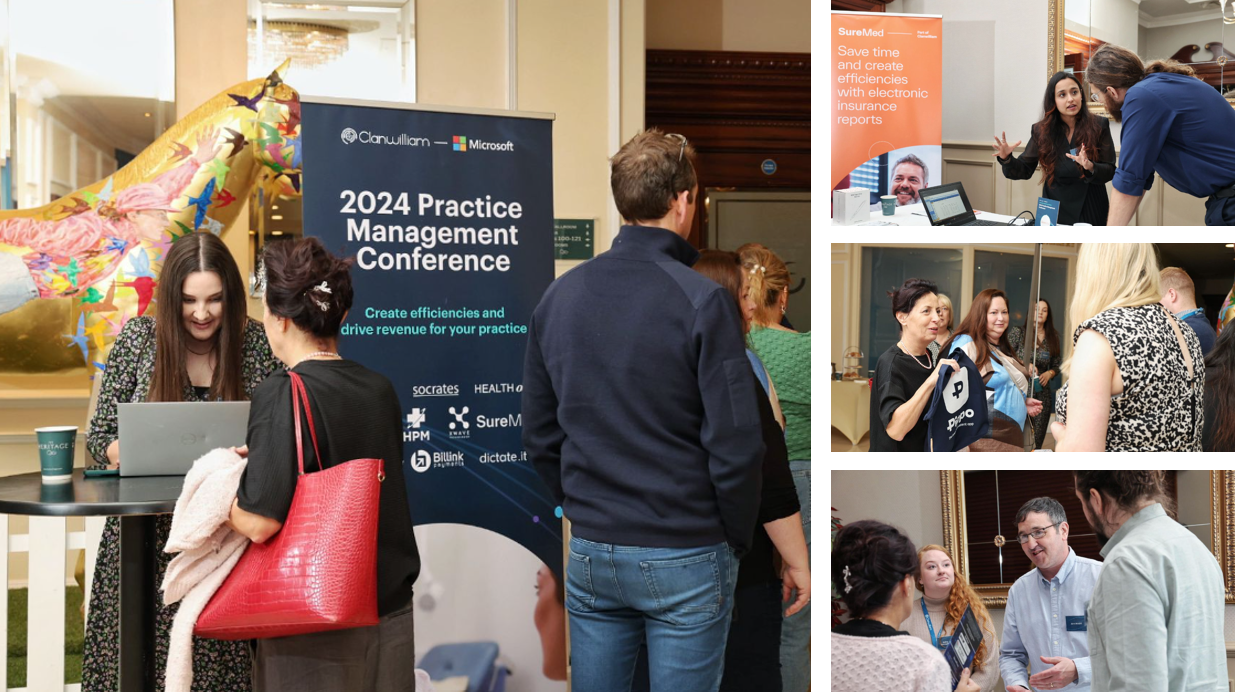Author: Lauren Turner
Support’s tip of the week
SureMed – Effortless electronic PMARs
Help us improve Socrates with your feedback
Thanks for joining us in Portlaoise
What an incredible morning.
To everyone who joined us at the Midlands Park Hotel on Friday 28th June — thank you. With over 200 attendees, the room was full of energy, curiosity, and collaboration.
We began the day with a series of short, focused presentations, showcasing the innovations we’ve launched in our recent releases — and a glimpse into what’s coming this September and beyond. From integrated AI tools that reduce admin time, to smarter finders, cloud readiness, and real-world improvements to STC workflows and Pippo, our goal is always the same: to help you work more efficiently, more confidently, and with greater impact.
Following the morning’s agenda, we split into smaller hands-on sessions for Socrates, Health One, and HPM users — packed with practical tips and direct support from our expert team.
Slides, session summaries, and recordings will be made available here later this week.
In the meantime, I’m sharing some moments from the morning — and once again, on behalf of all of us at Clanwilliam, thank you for being part of it.
Warm regards,
Eileen Byrne
Managing Director, Clanwilliam Ireland
New eReferral form for Vietnam War veterans
Veterans’ Affairs New Zealand has launched a new eReferral form for Vietnam veterans undertaking their Annual Medical Assessment (AMA).
Vietnam veterans are eligible for the free AMA, which can be carried out by their GP and is funded by Veterans’ Affairs New Zealand.
More than 3,000 New Zealand military and civilian personnel served in Vietnam between 1963 and 1975.
The AMA assesses the physical and mental health and wellbeing of Vietnam veterans, many of whom were exposed to a toxic environment resulting in long-term health problems.
The results of the AMA are reviewed by Veterans’ Affairs New Zealand and medical treatment and costs are covered for any conditions related to time served in the war.
New form makes it easier to access services
Veterans’ Affairs New Zealand principal clinical advisor Dr Mike O’Reilly says the new National form makes it easier for veterans to access services through a regular review.
“The process of submitting the AMA is now much easier, faster and more secure, which benefits both veterans and GPs.”
Mike says that in the past the process was paper based, which was time-consuming and involved a lot of back and forth.
“The hard copy form was sent to the veteran, they had to fill it out and take it to their GP, the GP had to fill it out then hand it back to the veteran who had to then send it to us.”
He says this was onerous for veterans and difficult for GPs.
Now the GP simply fills out the AMA electronically, with all the necessary documents attached, and sends it directly to Veterans’ Affairs New Zealand.
“The more information, and more complete information we have, the easier and quicker it is to process the form and get the support to our veterans.”
Building AMA into care plan beneficial
Mike says many veterans are concerned about the ongoing effects of the war on their health.
“It was a very inhospitable environment. Many were exposed to toxins such as Agent Orange and the impact on their health is a major concern,” he says.
“The AMA is a way for veterans, and us, to be able to longitudinally respond to changes in their health and support them.”
Mike says there is great value in GPs asking patients if they’ve ever served in the New Zealand Defence Force.
“If they are Vietnam veterans, then having a conversation about the AMA and building that into their care plan is hugely beneficial.”
How to send a Vietnam Veterans Annual Medical Assessment eReferral
The Veterans’ Affairs Vietnam Veterans Annual Medical Assessment form is available to GPs nationwide.
To submit a Vietnam Veterans AMA:
- Open the patient record within your PMS
- Select the HL Icon within the PMS to access the HealthLink launch page
- Click on “Veterans Affairs – Vietnam Veterans AMA” (under the referred services section) to launch the form.
We’re Listening: HealthLink Pauses Subscription Rollout for Consultation
At HealthLink, our priority is to make sure GPs can provide the most efficient and cybersecure service when it comes to their patient’s health data.
Every day, we send millions of important medical communications all over Australasia. That’s why we’re committed to investing in the highest quality data-protection technology that protects doctors and patients. Our sector is making innovative technological bounds at a rapid pace and we want to make sure our technology, services and support provide the same high-level efficiency across regional, rural and metro health systems.
To continue to be sustainable and provide our high-quality service, we’re seeking to introduce a robust contract and subscription model for all GP practices. This model will include all of our premium service offerings, such as comprehensive message inclusions and validation, provider directory access, SmartForms access to key national and state referral pathways and round-the-clock support.
We’ve heard the concerns from our GPs around the subscription model and how it applies to practices and various working challenges, such as part time doctors. Following this announcement of our intent we have paused the rollout of this new model while we explore all options and undergo a period of consultation over the coming months with stakeholders. We are actively consulting with the Royal Australian College of General Practitioners (RACGP), our customers, and other key stakeholders to ensure our system remains efficient, fair to all GPs and mindful of the growing needs of Australian doctors and practices.
We’re committed to open communication and will provide updates once the consultation period ends, and we are clear on next steps.
If you have any questions, please feel free to contact us at gpsubscriptions@healthlink.net.
Dictate.IT launches AI-powered Clinical Assistant
New technology will transform doctor-patient consultations saving clinicians time and reducing the burden of administration
Dictate.IT, part of Clanwilliam, a global healthcare technology and services group, has added an AI-powered clinical assistant to its market leading clinical documentation software products. The assistant listens to and transcribes the doctor-patient conversations in real-time, automatically creating consultation summaries, clinical notes and clinical documentation from the conversation transcript. The assistant saves time for healthcare professionals, reducing the burden of administration and allowing clinicians to spend more time on patient care.
The assistant is fully integrated with existing Dictate.IT clinical documentation products, so clinicians can start using it straight away, avoiding the need for busy hospitals to implement new software.
Dictate.IT is committed to the highest levels of security and privacy, meaning that no healthcare data is passed to a third party service for processing, and all healthcare data is stored within Dictate.IT’s own secure environment in the UK.
At every stage, the healthcare professional remains in control. They can check notes and clinical documentation against the transcript, and use a ‘smart recommendations’ option to identify points at which more information or investigation is required.
“We’re delighted to be bringing an innovative, AI-powered clinical assistant to our UK hospital customers.
We’ve been focused on giving doctors back valuable time through speech-to-text functionality for many years. Leveraging AI to create accurate doctor-patient conversation transcripts, consultation summaries, clinical notes and clinical documentation is a natural evolution of our expertise.
We look forward to working together with our customers on how to best leverage our innovations to solve their challenges and free up their valuable time.”
Stuart van Rooyen, Managing Director of Clanwilliam (UK)
The launch of the new technology comes at a time when the NHS is under huge pressure, and there is an intense need for tools to improve productivity, while addressing staff burnout, and delivering a more personalised service for patients.
In England, new health and social care secretary Wes Streeting has made a “move from analogue to digital” one of his three pillars for healthcare reform, and digital solutions are expected to feature heavily in the ten-year plan for the NHS expected next spring.
NHS staff have called for “long overdue” investments in health technology, and in a recent survey by the Health Foundation, 81% of respondents were in favour of its use for administrative tasks.
Dictate.IT’s AI-powered clinical assistant aligns with these developments. It acts as an intelligent virtual note taker, dramatically improving consultation efficiency by automating the documentation of patient interactions, creating appropriate and clinically relevant summaries, and integrating with the EPR or clinical system.
The assistant can be used with every doctor-patient consultation. Capturing and structuring data from these consultations is important for compliance, quality measures, care continuity, and in many cases reimbursement.
But traditionally it is also a multi-step process that takes time away from seeing patients. While many providers are exploring the use speech-to-text and natural language processing to streamline this process, generative AI helps take the workflow one step further.
By harnessing Dictate.IT’s investment in cutting edge, medically specific generative AI, recorded consultations can be turned to clinical notes and documentation that is ready to use within the clinical workflow.
The technology is available right now for NHS trusts and private hospitals.
New Single Assessment System workforce
The Australian Government’s My Aged Care service is the entry point for older Australians to access government-funded aged care. My Aged Care e-Referrals, powered by HealthLink SmartForm technology, were introduced in 2019 to provide fast, convenient and secure referral to My Aged Care.
The Department of Health and Aged Care is establishing a Single Assessment System to make it easier for older people to enter aged care and access different services as their needs change.
New Single Assessment System workforce
As the next stage of establishing the Single Assessment System, from 9 December 2024, the Single Assessment System workforce will bring together and replace:
- Regional Assessment Service (RAS)
- Aged Care Assessment Teams (ACAT)
- independent Australian National Aged Care Classification (AN-ACC) assessment organisations.
Under the Single Assessment System workforce, assessment organisations will be funded to conduct:
- all aged care needs assessments (both home support and comprehensive) for in-home aged care, flexible aged care programs, residential respite and entry into residential aged care, and/or
- residential aged care funding assessments to determine an older person’s AN-ACC classification.
State and territory governments will continue to deliver hospital-based assessments.
Updates to HealthLink e-Referral SmartForm naming conventions:
To support the transition to the Single Assessment System workforce, GPs may notice the following changes:
- Changes to the naming conventions in the GP e-Referral SmartForm: The terms “Regional Assessment Services (RAS)” and “Aged Care Assessment Teams (ACAT)” will be replaced with “Home Support Assessment” and “Comprehensive Assessment.”
These changes are being made to align with the new assessment process and will not impact Health Professionals’ ability to make a referral to My Aged Care.
More information:
Find out more information about the Single Assessment System for Aged Care on the Department of Health and Aged Care’s website.
My Aged Care e-Referrals resources including video tutorials, user guides and FAQs: https://www.healthlink.com.au/my-aged-care/
My Aged Care e-Referral Q & A – Heather Gewin
Bay Village Medical Centre in Killarney Vale, NSW, is an early adopter of healthcare technology, and has been using My Aged Care e-Referrals since 2019. In this Q & A with Heather Gewin, Practice Manager at Bay Village Medical Centre, we hear about the practice’s early adoption of e-Referrals, the benefits experienced and insights into how the practice’s operations have been enhanced. From improving efficiencies, to saving time for doctors and enhancing patient care, the adoption of e-Referrals has marked a significant improvement in processing aged care referrals.
What technological challenges prompted your practice to start using My Aged Care e-Referrals?
Bay Village Medical Centre adopted My Aged Care e-Referrals in 2019 to help streamline efficiencies in care for the doctors in our practice who regularly see around eight aged care patients in local nursing homes per home visit. Our doctors have a number of older patients in their care who require referrals to My Aged Care on a regular basis. Our practice wanted to embrace the technological changes happening in healthcare and make everything as electronic as possible. We found fax referrals to be unreliable and required extra work for the doctors as they had to use the fax machine in the general administration area. My Aged Care e-Referrals are faster and can be done straight from the doctor’s consulting room using our practice management software. e-Referrals are time saving and efficient.
What benefits has your practice experienced since using My Aged Care e-Referrals?
Our practice has noticed an increase in efficiency and time saving since we started using My Aged Care e-Referrals. e-Referrals have cut down the paperwork our doctors need to do. We’ve come a long way from paper files. The integration of e-Referrals within a patient’s electronic medical record provide continuity of care and are specific to an individual patient’s needs. We’ve found that e-Referrals lessen our doctors’ workloads. Having the ability to upload patient information easily and electronically saves valuable time and helps patients to get referred faster.
Anything else you’d like to add about your experience of using My Aged Care e-Referrals?
Moving to e-Referrals is the way to go. e-Referrals aid in the continuity of care, drive practice efficiency and address individual patient needs.




